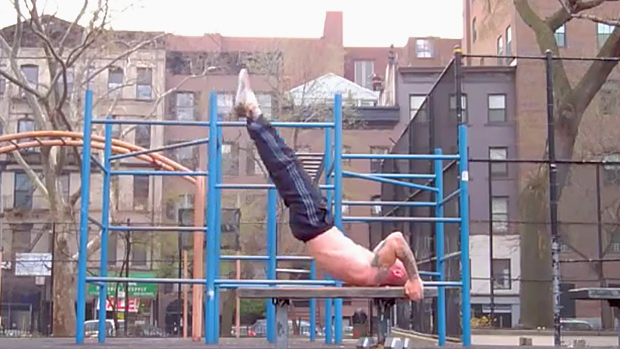Lead Photo Credit: Ross Edgley
If you're always doing pull-ups the normal way, you're leaving a lot of potential benefit on the table. Even worse, you could even be asking for some overuse injuries. The best way to avoid injuries and get the greatest benefit is to do the following variations.
Pull-Up Variations
- Scap Pull-Up: The initial movement in a pull-up needs to be a smooth movement emphasizing scapular depression. Working on scapular pull-ups and eventually doing scapular circles is the best way to achieve this. Start by hanging from a bar with straight arms. From there, keep the arms straight and perform what will look like reverse shrugs. Once you find this easy to do, start incorporating protraction and retraction, tracing the movement through a circle. You can do this using any grip.
- Lean Back Scapular Retraction: This is another variant of scap pull-ups. It's pretty much the same as described above but you're changing the direction of force and the angle of the torso relative to the arm so that you're closer to a row position. To do this, arch your back and bring the heels toward the head. Simultaneously pull the shoulders down and engage the lats. This will be very similar to the arm angle on a front lever, minus the core engagement.
- Swan Pull-Up: Also called Gironda pull-ups, the idea is to lean back as far as possible. This changes the line of force to something of a hybrid between a pull-up and a row. The top position is going to be very difficult to hold for many people. Nevertheless, attempt to hold the top for at least a one count on every rep for full benefit. If you don't feel your lats much on regular pull-ups, this will definitely do it. A neutral grip or rings work the best for this movement, but it can be done with any grip on any apparatus. Fully retracting and depressing the scapula is critical.
- L Pull-Up: The main challenge with an L pull-up is the initial movement from the hang. Raise your legs until they're parallel with the ground. Then, pull your chest up to the bar while maintaining your leg position. Lower your body to the starting position by letting your arms extend fully.
- Varied Grip Pull-Ups If you want to have a balanced program, you'll want to use a variety of grips. Here are some good options:
- Rings: The rings allow for full freedom of motion. Very elbow and wrist friendly.
- Neutral Grip (palms facing one another): This is one of the easiest grips with which to learn a pull-up. Also easy on the elbow and shoulders.
- Supinated (chin ups): For most, this will be the easiest grip with which to perform vertical pulls.
- Mixed Grip: This is a great position for a lot of people as it's a nice in-between of pull-ups and chin-ups. If you struggle with standard pull-ups (especially the top position), this can help you improve them.
- Narrow to Wide: Hands closer or wider isn't right or wrong, it's just different. Sometimes different is good. Play around with a variety of hand widths and see what feels right.
- Grip Challenges: Using a set of thick ropes, revolving handles, pinch blocks, rock climbing trainers, etc. has a host of benefits and it makes your claws stronger.
- Tuck Lever Row: If you were to put these exercises on a spectrum from vertical to horizontal line of pull, this is on the far horizontal end, right after a swan or Gironda pull-up. Perform a front lever to get your body horizontal to the ground, simultaneously pulling your legs into a tuck position. From there, use your arms to row your body up towards the rings.
- Ice Cream Maker: Here you transition from a front lever to the top position of a pull-up. The nice part about this drill is that it teaches you to keep the lats engaged throughout, especially at the top position. This is best done from a tuck position at first and eventually moving toward a straight body position.
- Fast/Slow: Many people with tight shoulders are able to perform well over 10 reps, but can't even do 1 rep if asked to do it slowly. This is because they're strong in certain areas (joint angles), but not in others. A combination of slow reps and isometric holds can help fix this problem and improve the strength and flexibility of the shoulders. That being said, the hallmark of a good athlete is to move at speed, so once you lay a solid foundation with controlled and slow movements, let's occasionally see some speed, too.
- Freestyle: This combines some of the other variations described here, but also fundamentally includes trunk rotation, leg movements, and lateral shifting. This isn't just for street-workout aficionados. Marisa Inda, a champion powerlifter, is famous for her brand of freestyle pull-ups. She's pretty freakin' strong, so maybe you should do these, too.
- Top Position Holds: If some of the above exercises are too challenging, start with a top-position isometric hold. Start on rings, or with a neutral or supinated grip on a bar. Guys generally struggle more with holding the top position and women struggle more with getting up from the bottom position. Work up to the point where you can hold the top position for at least 30 seconds, eventually working up to a minute. Make sure the shoulder blades are down and the neck is long. You can use this position to work toward a swan pull-up by pulling up to the top position first and then extending the hips and spine toward the swan position.





